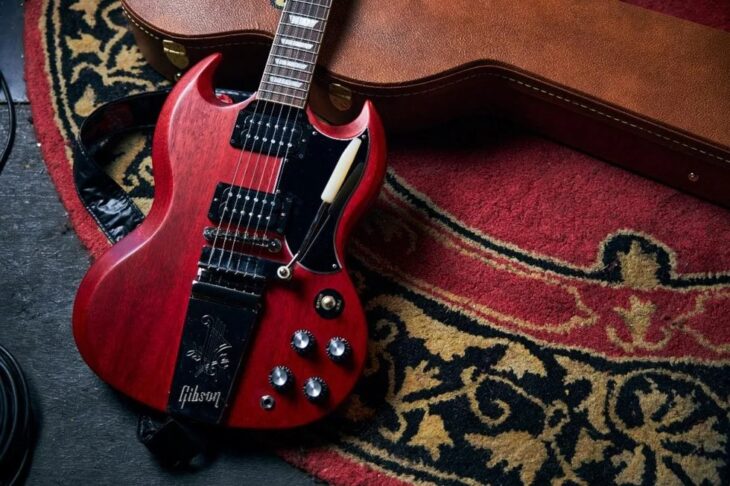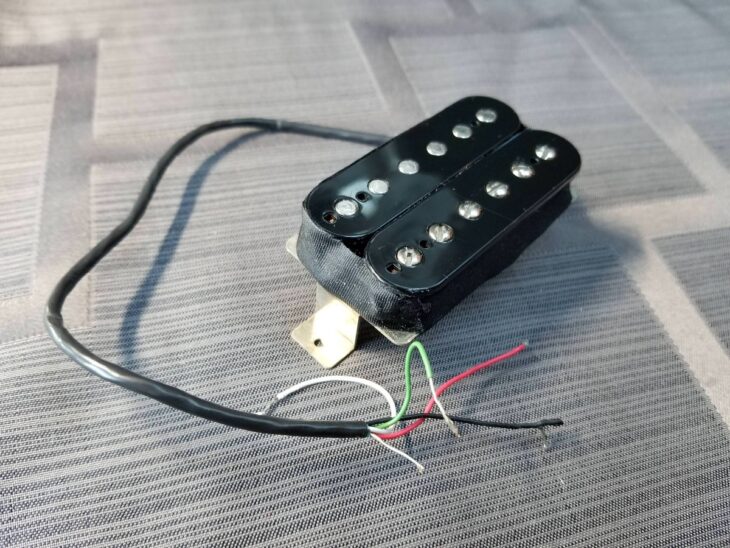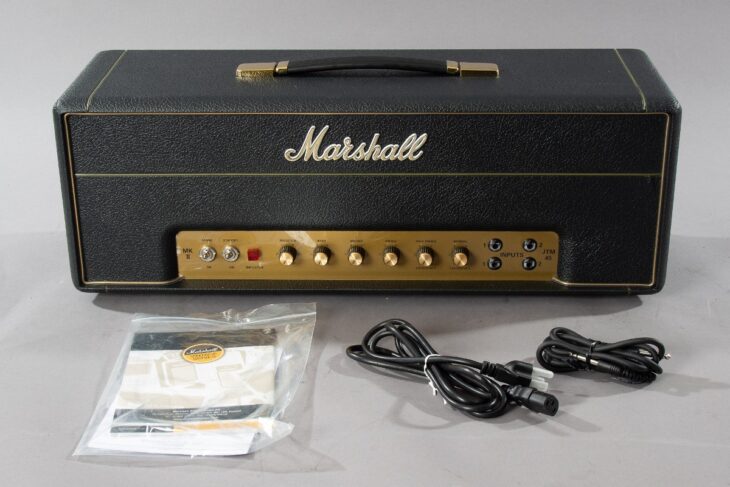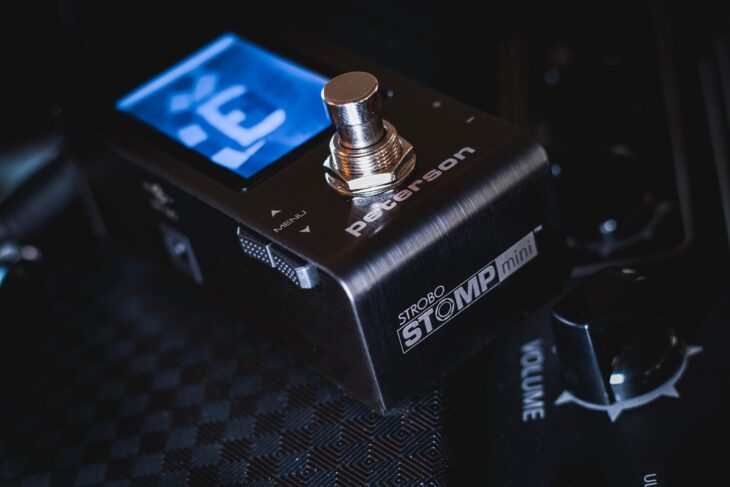Ghost’s incendiary live shows, catchy tunes, and wholehearted (if somewhat tongue-in-cheek) embrace of the theatrical has made the Swedish band into bona fide metal festival superstars.
Ghost is the brainchild of Tobias Forge, a veteran of Sweden’s metal underworld. Before hitting the big time with Ghost, Forge played with death metal band Repugnant and glam metal band Crashdiet.
Blending the seemingly disparate influences of these two sides of the heavy metal coin gave birth to Ghost.
Forge, usually performing under the name Papa Emeritus, has been Ghost’s primary songwriter and the face of the band since their launch in the late 2000s.
Although Tobias Forge is the sole (officially) named member of the band and their primary songwriter, he rarely plays guitar for Ghost. Instead, he leaves that task to his ultra-theatrical backing band, the Nameless Ghouls.
In this article, I’m going to take a deep dive into the gear used by the Nameless Ghouls of Ghost live and in the studio.
I’ll include affordable smaller-scale alternatives to their gear for guitar players looking to capture some of the Ghost mystique in their bedroom or on a smaller stage.
Table of Contents
Guitars
The main Ghost guitar is the oddly-shaped Gibson RD. This guitar was launched in 1977, only to be discontinued in 1982. Later reissues have come and gone, but it’s most likely that Ghost’s RD Artist is an original from the late 70s.
The Gibson RD was an attempt to appeal to guitar players with an interest in synthesizers. Accordingly, it featured onboard effects, including compression and both treble and bass boosts.
The Nameless Ghouls’ Gibson RD has Seymour Duncan pickups installed with a coil-tap switch.
The other Gibson in the Ghost arsenal is the far more familiar SG. The Gibson SG Standard has long been a hard rock mainstay thanks to its upper-fretboard accessibility and two powerful humbuckers.

The Nameless Ghouls, being Swedes, are also quite partial to Hagstrom guitars. The Hagstrom Fantomen, which looks not unlike the Gibson RD or Firebird, is their model of choice.
The Fantomen was actually designed in collaboration with Ghost, and production models are virtually identical to those played by the band themselves.
Guitar players looking to capture the Ghost tone would do well to start with a Gibson-style guitar. The Epiphone SG Standard is one affordable option.
I would also recommend replacing the stock pickups with Seymour Duncan pickups. Specifically, I recommend the Seymour Duncan 59 humbucker set.

Bear in mind that the Gibson SG is more commonly heard than seen when it comes to Ghost. It’s not a common onstage guitar, as the band prefers their RD models live.
The SG is all over Ghost’s albums, however, and is a major part of their recorded sound.
Tuning
Ghost play almost all of their music in D standard tuning (D-G-C-F-A-d), a whole step down from E standard.
To facilitate this, and maintain good intonation, you may want to set your guitar up with strings a gauge heavier than you typically use.
Amps
The Nameless Ghouls lean towards classic British-sounding amps for their crushing sound.
In the studio, they generally blend Marshall, Orange, and Fender amps to get a broad range of tones.
Live, however, like most bands of their ilk, Ghost are devotees of Marshall and Orange amplification.
The Nameless Ghouls used a variety of Marshalls, including Plexi and JCM800 models.

These don’t exactly come cheap, so guitar players looking for a more wallet-friendly alternative may want to consider a smaller combo amp.
The Marshall Studio Classic 20C is a more affordable option for an authentic-sounding vintage saturated Marshall tone. It’s based heavily on the old-school JCM800s that fuelled the sound of 80s metal.
For more tonal diversity, the Marshall DSL40CR is about half the price. Its tone isn’t as close to that of the JCM800, but it provides plenty of classic Marshall grunt.
Orange amps have a very distinctive tone, so if you’re looking to capture that element of the Ghost sound, I highly recommend the Orange Dark Terror. This lunchbox-sized amp is built for high-gain tones.

An even smaller option for the Orange tone is the Terror Stamp, a pedal-sized amplifier with 20 watts of power.
Ghost Amp Settings
The Ghost sound has plenty of grint and crunch but is not fizzy or fuzzy. I recommend the below settings as a starting point, from which point you can tweak the amp as you see fit.
Most of the Ghost guitar tone comes from driving an old-school tube amp such as an Orange or a Marshall. Volume, gain, and midrange are the keys to this kind of tone.
Volume: 5
Tube amps need volume to deliver crunch. Start at 5 and turn up if you need to.
Gain: 6
You want enough gain to drive your amplifier, but not so much that you lose not clarity.
Bass: 4
Ghost’s guitar tone is not overly warm or muddy. Bass at 4 lets the other frequencies shine.
Mids: 7
Most of the expression and articulation in the Ghost tone comes from the mids. This is a fairly standard setup for rock guitar.
Treble: 7-8
Depending on how dark the voice of your amp and guitar is, be prepared to compensate with more treble. This gives your playing more definition.
Ghost Pedals
The main pedal used by the Nameless Ghouls is the most important of all: the Peterson tuner to ensure that the guitar is always tuned to perfection.

While it is not strictly a guitar pedal, these days the Nameless Ghouls use the AXE-FX in their live rig. This amp modeling unit is used in place of an actual guitar amplifier for the more rigorous requirements of their bigger tours.
Otherwise, the guitar players in the band avoid using too many pedals live. Instead, they rely on the interplay between guitar and amplifier to deliver their guitar tones.
Picks
The guitar players from Ghost use Dunlop Tortex 1.14 guitar picks. These are customized by the Nameless Ghouls’ guitar tech with a box cutter, used to carve lines into the surface of the pick to allow extra grip.
Closing Thoughts
The guide above should get you close to Ghost’s crushing, powerful guitar tone. A detuned humbucker-equipped guitar and an overdriven tube amp will get you most of the way to nailing the earworm riff from “Square Hammer” in no time.

